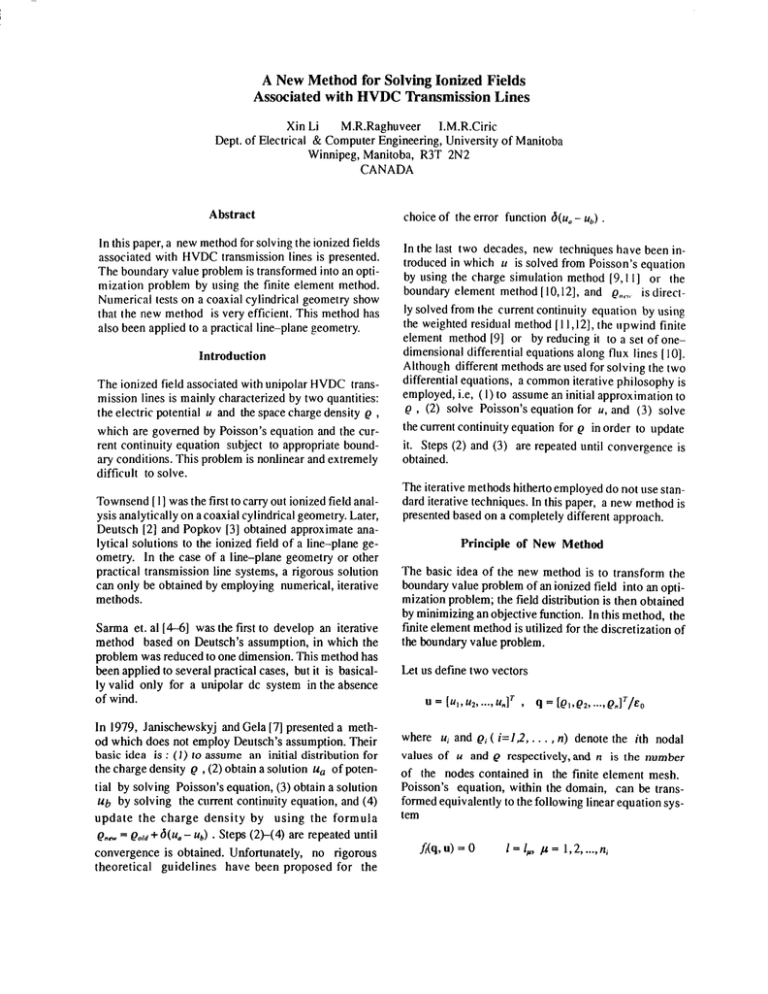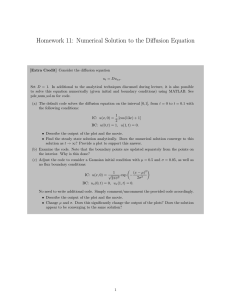C43 - University of Manitoba
advertisement

A New Method for Solving Ionized Fields Associated with HVDC Transmission Lines Xin Li M.R.Raghuveer I.M.R.Ciric Dept. of Electrical & Computer Engineering, University of Manitoba Winnipeg, Manitoba, R3T 2N2 CANADA Abstract In this paper, a new method for solving the ionized fields associated with HVDC transmission lines is presented. The boundary value problem is transformed into an optimization problem by using the finite element method. Numerical tests on a coaxial cylindrical geometry show that the new method is very efficient. This method has also been applied to a practical line-plane geometry. Introduction The ionized field associated with unipolar HVDC transmission lines is mainly characterized by two quantities: the electric potential u and the space charge density e , which are governed by Poisson's equation and the current continuity equation subject to appropriate boundary conditions. This problem is nonlinear and extremely difficult to solve. Townsend [I] was the first to carry out ionized field analysis analytically on a coaxial cylindrical geometry. Later, Deutsch [2] and Popkov [3] obtained approximate analytical solutions to the ionized field of a line-plane geometry. In the case of a line-plane geometry or other practical transmission line systems, a rigorous solution can only be obtained by employing numerical, iterative methods. Sarma et. al [4--6] was the first to develop an iterative method based on Deutsch's assumption, in which the problem was reduced to one dimension. This method has been applied to several practical cases, but it is basically valid only for a unipolar de system in the absence of wind. In 1979, Janischewskyj and Gela [7] presented a method which does not employ Deutsch's assumption. Their basic idea is: (1) to assume an initial distribution for the charge density (J , (2) obtain a solution Ua of potential by solving Poisson's equation, (3) obtain a solution Ub by solving the current continuity equation, and (4) update the charge density by using the formula fluw = eo1d + b(ua - uh) . Steps (2)-( 4) are repeated until convergence is obtained. Unfortunately, no rigorous theoretical guidelines have been proposed for the choice of the error function O(u 0 - ub) . In the last two decades, new techniques have been introduced in which u is solved from Poisson's equation by using the charge simulation method (9, 11] or the boundary element method [ 10, 12], and (!,,,.,, is directly solved from the current continuity equation by using the weighted residual method [11,12], the upwind finite element method [9] or by reducing it to a set of onedimensional differential equations along flux lines [I OJ. Although different methods are used for solving the two differential equations, a common iterative philosophy is employed, i.e, ( 1) to assume an initial approximation to (! , (2) solve Poisson's equation for u, and (3) solve the current continuity equation for e in order to update it. Steps (2) and (3) are repeated until convergence is obtained. The iterative methods hitherto employed do not use standard iterative techniques. In this paper, a new method is presented based on a completely different approach. Principle of New Method The basic idea of the new method is to transform the boundary value problem of an ionized field into an optimization problem; the field distribution is then obtained by minimizing an objective function. In this method, the finite element method is utilized for the discretization of the boundary value problem. Let us define two vectors where u; and (J; ( i=l ,2, ... , n) denote the ith nodal values of u and (! respectively, and n is the number of the nodes contained in the finite element mesh. Poisson's equation, within the domain, can be transformed equivalently to the following linear equation system .li(q, u) = 0 l = l,., µ = 1, 2, ... , n; where I = lw µ = I, 2, ... , n; represent the interior nodes of the finite element mesh. The current continuity equation, in which the effect of wind may be considered, can be transformed to the following nonlinear equation system t/J1(Q, u) =0 I= 1,2, ... ,n Thus the ionized field can be solved by finding q' and u' which satisfy The domain is subdivided into a mesh with 1680 triangular elements and 880 nodes. The minimization of the formulated objective function is carried out by using Newton's method [ 14, 15] which has the fastest rate of convergence. The numerical solutions for (! and u , shown in Figs.2 and 3 respectively, correspond to the case when the potentials of the electrodes and the field strength at the inner conductor surface are taken as the boundary conditions. 2 .fi(q,u)=O (!/t: 0 (MV /m ) l=lw µ= 1,2, ... ,n, 2001.-~~~~~~~~~~---, tp 1(q,u)=0 /=1,2, ... ,n subject to specified boundary conditions analytical solution 150 This problem is equivalent to the following unconstrained optimization problem: + numerical solution 100 Minimize n; n F(q, u) 1/Jf(q, u) + L~(q, u) + Fb(q, u) =L 1-1 µ-I 50 0-h,-,--,--,,,.,-,-,-,.-,--,-,-,-,-,-,-,-.,-" I where F(q, u) is called the objective function. The term Fb(q, u) corresponds to the boundary conditions. 3 5 7 9 II 13 15 17 19 T(mm) and any form of boundary condition. Fig.2. Analytical and numerical solutions for(! along a radius. (Field strength at inner conductor is specified). The problem can now be solved by using standard iterative methods such as Newton's method. u (kV) Fb(q, u) can be formulated for any shape of boundary Numerical Tests The new method is applied to a coaxial cylindrical model shown in Fig. I, for which the analytical solution is available [7]. 0 V0 (! 0 - 20 numerical solution 15 01+.-.,......,.-,-..,.....,""'"T"-.--r--r-r-..,.....,-,-..,-.,......,.-,-..,...... l = 17.5 kV = 1.03994 mC/m3 u=O Fig. I. Coaxial cylindrical geometry, V0 - onset voltage, (! space charge density at T = 0 analytical solution 5 R =20 mm T0 =I mm V = 25kV u= V 25 IO radius R radius To 30-,....-~~~~~~~~~~--, 3 5 7 9 11 13 15 17 19 T(mm) Fig.3. Analytical and numerical solutions for u along a radius. (Field strength at inner conductor is specified). The errors in the numerical solutions for T0 • and u are shown in Fig. 4. The performance of the iterative algorithm is shown in Table I . (! op(%) When the space charge density at the inner conductor surface is specified as a boundary condition instead of the field strength, the performance of Newton's iterative method is similar. The errors in the numerical solutions for Q and u , in this case, are shown in Fig.5. 3 0,.(%) 2.5 2 1.5 The above results show that the proposed algorithm is very efficient. It takes only 4 iterations and I '25" of CPU time for convergence. The calculated results show a good agreement with the exact values in a coaxial cylindrical geometry. 0,.(%) 0.5 - -- 0 I 3 5 7 9 11 13 15 17 19 r(mm) Fig.4. Percentage errors in numerical solutions for (J and u . (Field strength at inner conductor is specified). Table I. Performance of the i1erative algorithm. Initial value q(01 = [0.5, .. ., 0.5Y(Jo/fo In addition, the proposed method is applied to a lineplane geometry (Fig.6) with absence of wind. The potentials at the electrodes and the space charge density at the line conductor surface are taken as the boundary conditions. A rectangle with height= 2H (m) and width= 50 (m) is taken as the solution domain. The boundary conditions at locations which do not coincide with the conductor surface and ground plane are determined from the associated space charge free field [9]. The domain is divided into a mesh with 2560 triangular elements and 1320 nodes. k(No. of iterations) F( q(k>, u(k') 0 6.70 x 102 r0 = I 7.31 x 10° 1.67 x 10- 2 V = 275 kV (Jo= 88.54 µC/m 3 1.91 x 10- H= 6.144 m 2 4 3 4 1.84 x 10-4 5 1.84 x 10-4 x (m) Fig.6. Line-plane geometry, SPARC 10 workstation: CPU time : l '25" op(%) 3 mm Qo - space charge density at r = ro. Eg(kV/m) 3 40~~~~~~~~~~~~~~~~~ ionized field space charge free field 0.(%)2.5 30 2 1.5 20 o"(o/o) o.(%) ~ 0.5 0 I 3 5 7 9 11 13 15 17 19 r(mm) Fig.5. Percentage errors in numerical solutions for (} and u . (Space charge density at inner conductor is specified). 10 0+-~--,r--..,...--r-~~~~~~~~~..,...-~ -15 -IO -5 0 5 IO 15 x (m) Fig.7. Electric field profile at ground level. The calculated field profile at ground level is shown in Fig.7. The performance of the iterative algorithm is shown in Table 2. In this case also the iteration converges fast and stably. [2] W.Deutsch, Ann. Physik, Vol.5, pp. 589-613, 1933. [3) V.I.Popkov, Elektrichestvo, No.I, pp.33-48, 1949. Table 2. Performance of the iterative algorithm. Initial value q<0> = (0.4, ..., 0.4Y(>0 /Eo k(No. of iterations) F( q(*>, uCk') x 102 0 4.51 2 f.33 X J0 1 4 x 10- 1 2.37 x 10- 2 2.19 x 10-) 1.39 x 10-4 1.27 x 10-4 5.57 6 8 10 11 SPARC 5 workstation: CPU time: 4'43" Conclusions A new method is proposed for the solution of ionized fields by transforming the boundary value problem to an equivalent optimization problem. Several standard iterative methods (such as Newton's method used in this paper) developed on firm mathematical bases can be applied to solve the transformed problem. Numerical tests show that the proposed method is very effective in terms of speed and accuracy. The calculated results show a good agreement with the exact solutions in the case of the coaxial cylindrical geometry. The method has also been successfully applied to a lineplane geometry. This method is generally applicable for solving ionized fields. The form or structure of the objective function does not depend on the domain geometry. The boundary conditions can be easily treated. The effect of wind can be easily included into the objective function. In addition, this method can also be extended to the bipolar cases. This problem is under formulation and the results will be published in the near future. [4) M.P.Sarama and W.Janischewskyj, IEEE Trans., Vol.Pas-88, pp.718-731, 1969. [5] M.P.Sarma and W.Janischewskyi, IEEE Trans., Vol. PAS-88, pp.1476--1491, 1969. [6] M.P.Sarma, IEEE Trans. on Elec. Insul., Vol. EI-17, No.2, pp.125-130, 1982. [7] W.Janischewskyj and Gela, IEEE Trans., Vol. PAS-98, pp. I000-1011, 1979. (8) M.Abdel-salam, M.Farghally and S.Abdel-Sattar, IEEE, Trans. on Electrical Insulation, Vol.El-18, No.2, 1983,pp.110-119. (9) T.Takuma, T.Ikeda and T.Kawamoto, IEEE Trans., Vol.PAS-I 00, pp.4802-4810, 1981. [IO] E.Kuffel, A.Dzierzynski and J.Poltz, "Final Report on: Development of Numerical Method for Analysis of Bipolar Corona on HVdc System", The University of Manitoba, January 28, 1987. [ 11] B.L.Qin, J .N .Sheng, Z. Yan and Gel a, IEEE Trans. on Power Delivery, Vol.2, No. I, pp.368-376, 1988. [ 12] Ming Yu, Ph.d Dissertation, The University of Manitoba, 1993. [ 13] O.C.Zienkiewicz and K.Morgan, "Finite Elements And Approximation", John Wiley & Sons, Inc., New York, 1983. [ 14) S.L.S.Jacoby, '1terative Methods for Nonlinear Optimization Problems", Prentice-Hall, Inc., Englewood Cliffs, New Jersey, 1972. [ 15] J.Kowallk and M.R.Osbome, "Methods for Unconstrained Optimization Problems", American Elsevier Publishing Company, Inc., New York, 1986. Acknowledgement References [I] J.S.Townsend, Phil. Mag., Vol. 28, p.83, 1914. Financial support from NSERC, Canada and Manitoba Hydro through the Manitoba Hydro Research and Development Committee is gratefully acknowledged.
